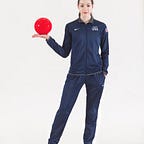What Exactly are the Body Difficulties of Rhythmic Gymnastics
In addition to extensive apparatus work, rhythmic gymnastics routines are also composed of a variety of body difficulties (informally known as elements) that split into three main sub-categories: balances, turns, and jumps.
Although each subcategory is required to be performed at least once per performance, the total number of elements permitted in a single routine is determined by a gymnast’s level. The older and higher-level the gymnast, the more elements (up to nine) they are allowed to showcase.
Of course, there are many, many various rules and criteria that apply to each of the body difficulties in their respective sub-categories, but before one can look at the scoring and point system, one must learn about the foundations of what each element is.
(Side note: point values will not be discussed in this article.)
Balances:
Often considered to be a foundation for the other two categories, balances can either be performed on a flat foot or a relevé (think tippy-toe). To do a balance properly, a gymnast must have very strong muscles and a great sense of her center of mass. That’s right, physics manages to manifest itself even in gymnastics.
From a panshé to a side inclination, there are many different variations of balances (often inspired by ballet) that a gymnast can choose to perform. Nevertheless, the general criteria between the varients stay more or less the same. In order for the balance to be counted, a near-perfect shape (of the body and legs) must be fixated for a minimum of one second and until completion of the mandatory apparatus work.
If a balance is performed with a small mistake such as an imperfect shape or a wobble, the balance itself might still count but be given a penalty, or deduction in its value—an execution fault.
Turns:
As sung by Rhianna, “round and around and around we go.” Creating an awing effect, turns are all about finding the correct combination of balance, momentum, speed, and control.
Although turns are performed in many of the same shapes as balances, they must be done without heel support, on a relevé. Upon reaching their final shape, turns are scored per rotation completed. In order to ensure that the maximum number of turns gets scored, many gymnasts turn a number and a half (i.e. not just four turns, but four and a half in order for four to be counted).
Different shapes or leg positions of turns may be also combined together to create a “Frankenstein-ed” variation of a turn.
Jumps:
Seemingly propelling a gymnast through the air, jumps are dynamic bursts of flexible energy. In order for the gymnast to score any amount of points from the jumps, the shapes of the leaps must be well-defined and should reach a sufficient height.
While some leaps use a lot of flexibility and coordination, others are a little more simplistic. Many jumps reflect those of ballet and utilize the same technique. When jumping, gymnasts are often told that it is like a balance in the air. and as with turns and balances, a type of apparatus handling (toss, catch, spin, etc.) must be completed on the jump for it to obtain credit.
Dancing Steps*:
Although not an element, the dance steps are judged by a body difficulty judge. According to the current (2020) code of points, each dance step must be at least eight seconds long and should match the tempo, rhythm, character, and accents of the music. It should also include a change in level, rotation, directions, and modalities and needs to include at least one form of fundamental apparatus handling (such as a roll, bounce, flip, etc.).
Conclusion:
Generally speaking, rhythmic gymnasts mix and match the elements they do but may not repeat an identical element more than once per routine. Nevertheless, one may see a gymnast performing three of the same jumps in a row. An identical repetition of two or more jumps constitutes as a series and although each leap is counted as an individual (i.e. 3 leaps in a series count as three), the element may be repeated. That said, different types of balances may also be connected to save time. When that occurs, each component of the combination is judged as its own element. All said, one can do more elements than just the maximum nine, but only the nine highest-scoring ones will count towards the final score.
If you would like to know more about the rhythmic gymnastics apparatuses, please follow this link: https://medium.com/@egriskenas
